Comtrend PG-9172 Powerline Adapter Review: G.hn Gets Primed for Retail Push
by Ganesh T S on May 3, 2016 8:30 AM EST- Posted in
- Powerline Adapters
- Networking
- Marvell
- G.hn
- HomePlug
- Comtrend
HomePlug and G.hn Go Head to Head
This section presents the benchmark numbers obtained for the four different test cases outlined in the previous section. The Comtrend PG-9172 numbers are graphed in red, while the ZyXEL PLA5405 (representing HomePlug AV2 with MIMO support) numbers are in blue. The main tussle is between these two adapters - they are close in price (USD 77 vs. USD 83) and represent the best possible implementations of the two standards in the evaluated set.
Performance Metrics - TCP Downlink and Uplink
Node A represents the shortest physical distance between the tested nodes. This is a close fight between the HomePlug AV2 and G.hn adapters, with the PG-9172 coming out with a slight lead. Surprisingly, the ZyXEL PLA5206 SISO adapter is better than the PLA5405 in this scenario.
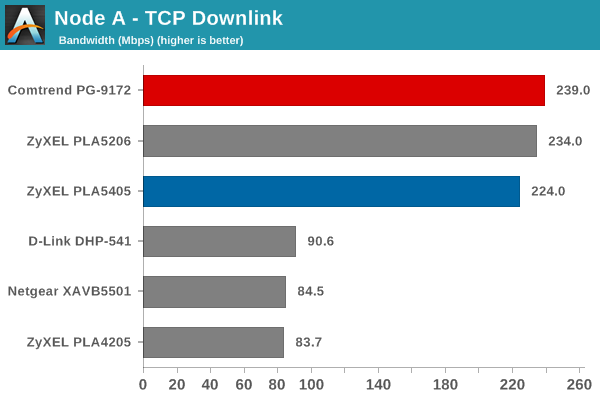
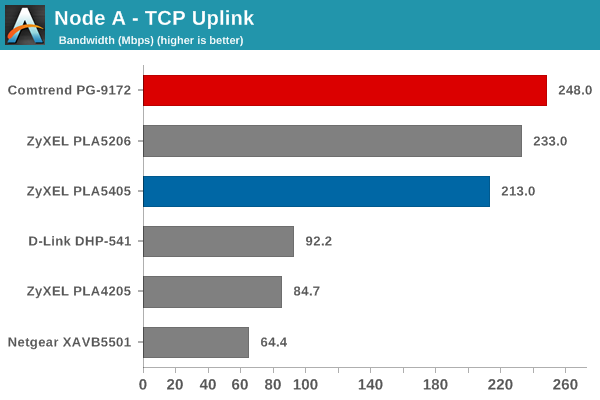
Node B is the garage outlet across the AFCI circuit breaker. The SISO adapter is the surprise winner here, though the G.hn PG-9172 comes a close second. The PLA5405 comes in third, quite a bit behind the G.hn adapter.
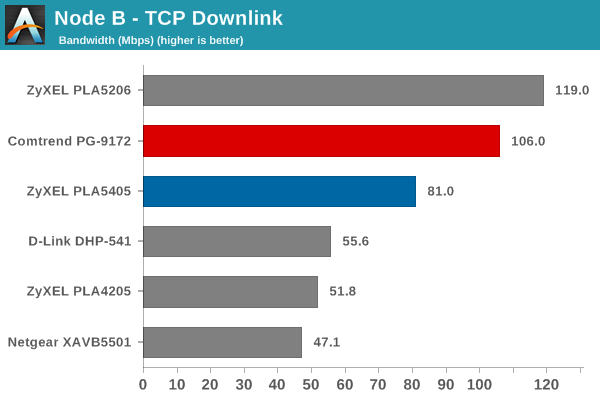

Node C is in the same wall as the garage outlet, and across the circuit breaker again. Here, the Comtrend adapter performs quite well, though it is really hard to choose between the HomePlug AV2 adapters and the G.hn adapter given the small differences in the bandwidth numbers.

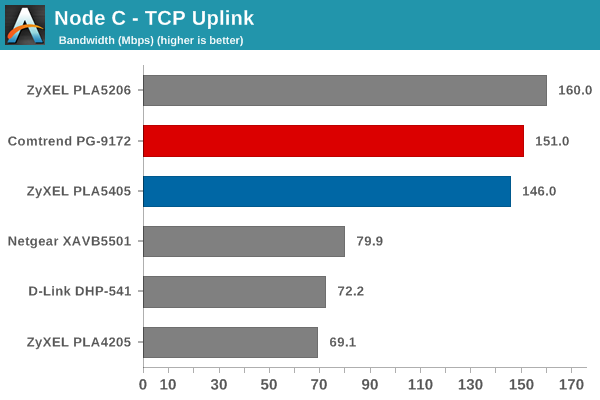
Node D is one of the farther outlets from the master node, and the Comtrend PG-9172 adapter establishes a clear and sizable lead over the HPAV2 adapters.
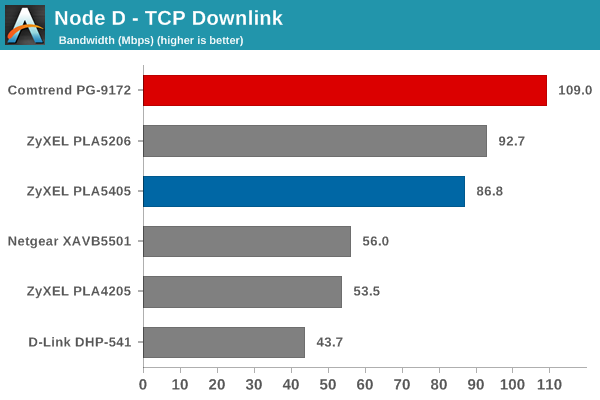
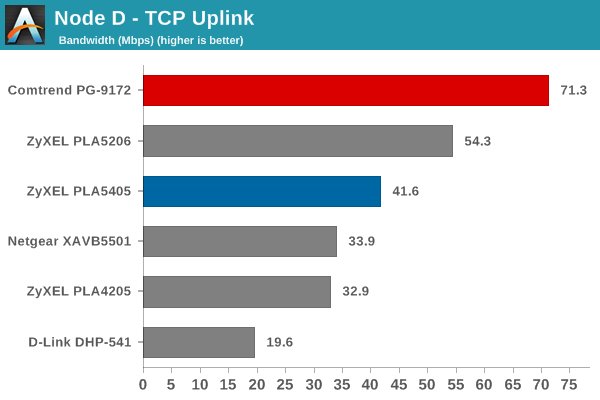
Node E is in the adjacent room, and is one of the closer adapters (similar to Node A). The performance ordering is also similar.
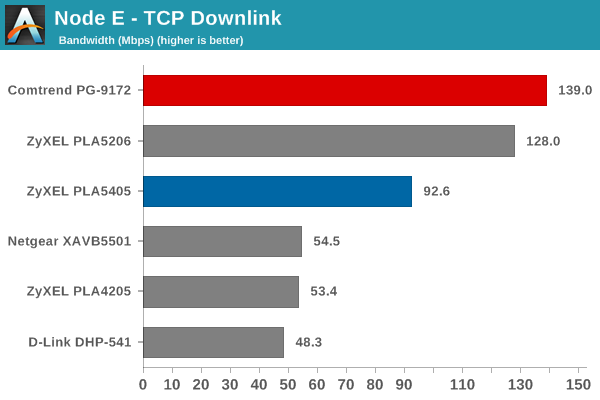

The Comtrend PG-9172 emerges as the clear winner in Node F.
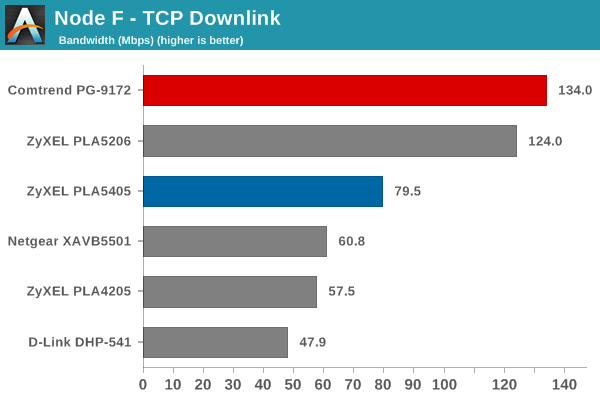
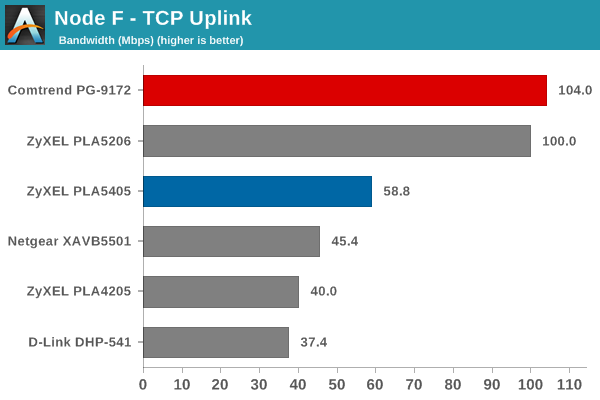
Performance Metrics - UDP Downlink and Uplink
The UDP results across all the nodes are similar in ordering to the TCP results.
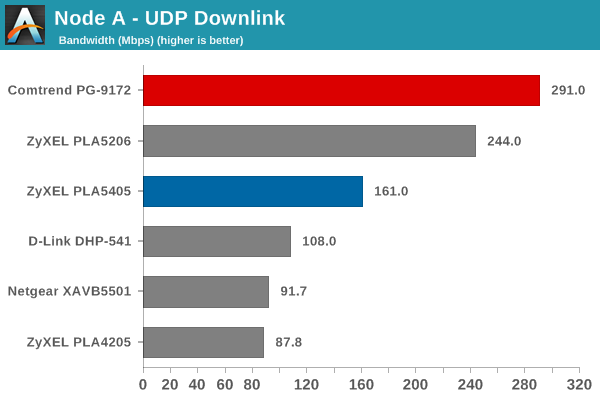
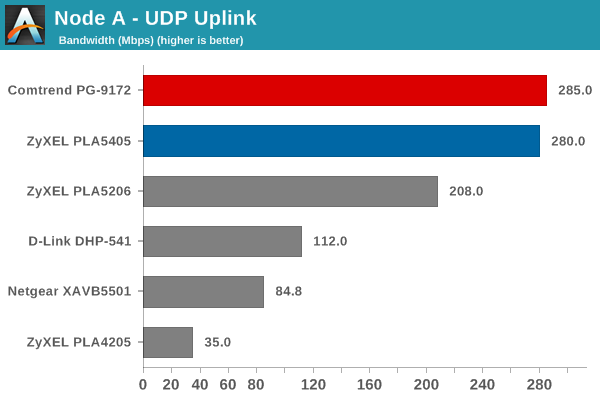
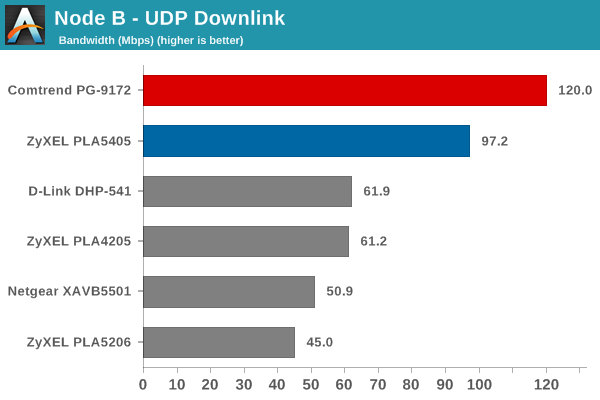
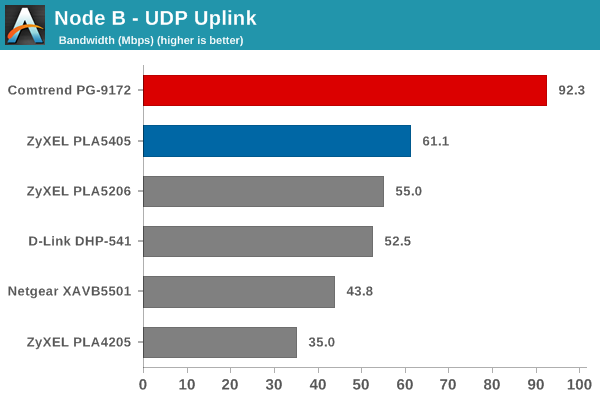
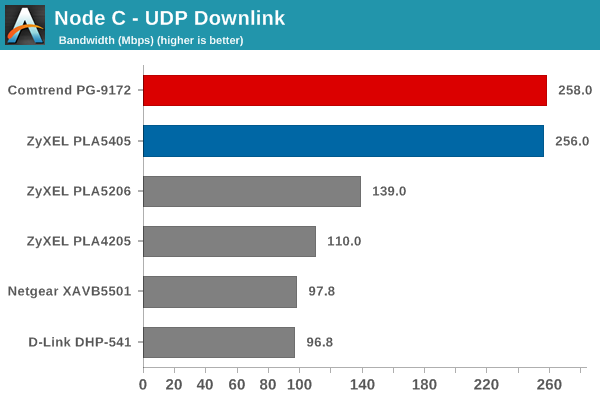
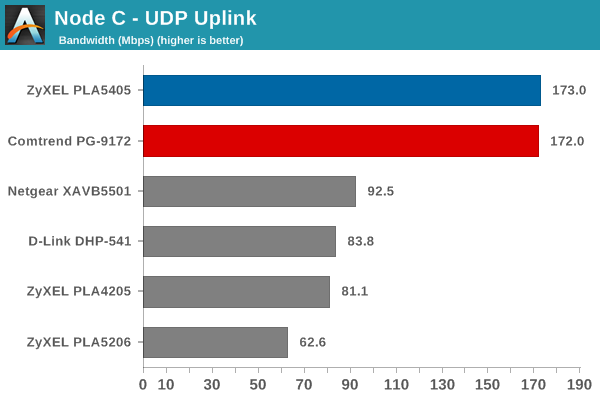
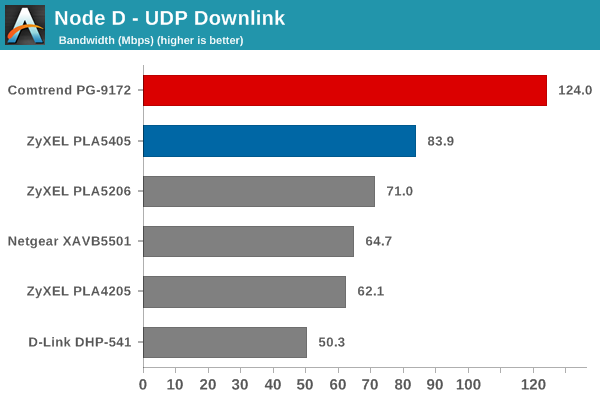
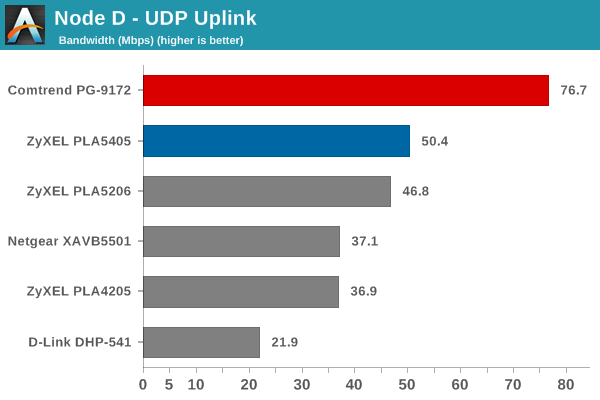

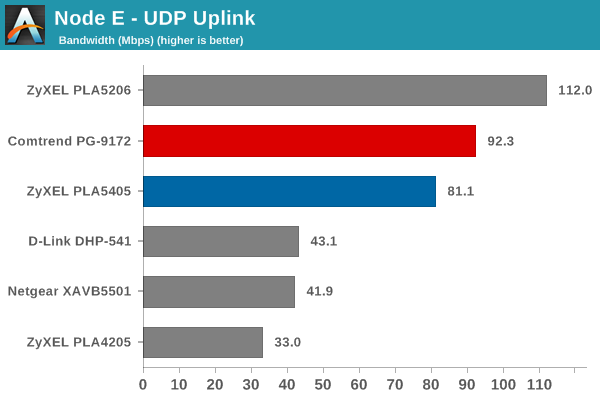
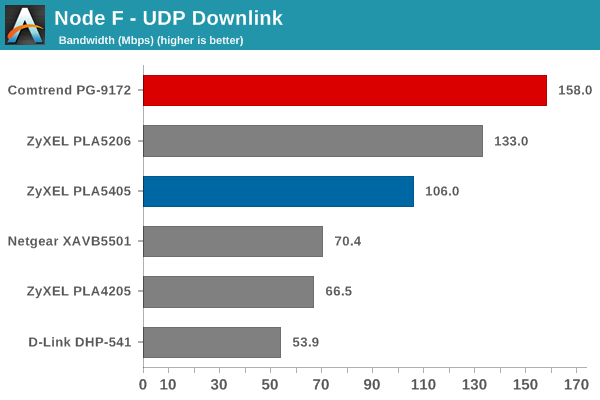
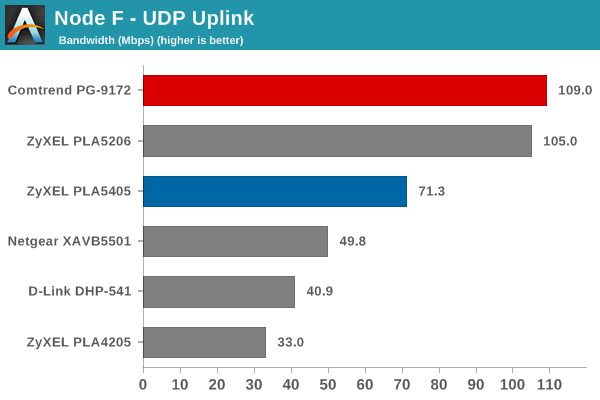
The above results show that the Comtrend PG-9172 G.hn adapter has the best performance in almost all of the tested scenarios.










48 Comments
View All Comments
gobaers - Tuesday, May 3, 2016 - link
My current setup is two Ubiquiti Unifi access points, one connected directly into the firewall and the other connected via TP-Link HomePlug adapters, as well as an IP phone via HomePlug adapter as well. They're somewhat reliable, but I see one of the powerline adapters drop connectivity every few days. Really, I should wire the house with Cat6, but it's going to be a messy job.Replacing the consumer Netgear WNDR3400 with a Cisco ASA5505, and adding Unifi WAPs has been an awesome. Running the Unifi controller software on a desktop, live handoffs and great wifi through the house, it has been rock solid at least until the powerline adapter disconnects.
Acarney - Tuesday, May 3, 2016 - link
Any word on ping times with just a single brand/point to point network setup? I'm mainly looking to hardware my TV/AppleTV/PlayStation 4 with my network. I have an old G wifi hub connecting via bridge mode to my router which is about two rooms over. I need to hard connect these devices because if I don't they decide to connect to the wifi access point upstairs... Which is ok, except it randomly drops occasionally to where the one downstairs a couple rooms over is stronger. It's just a pain if gaming or streaming and a cut out happens. My internet pings are about 25 to 35ms at the best. Would a power line network drastically extend those? (Say into 100ms+) if it was just router -> power line plugin -> power line plugin -> network hub to break it out into 3 plugs for TV, AppleTV, PS4.paranoised - Thursday, May 5, 2016 - link
I have a Homeplug AV2 device and the latency I see is typically in the 2-4 milliseconds. Using powerline networking will probably increase your throughput and reduce latency tangibly.rtho782 - Tuesday, May 3, 2016 - link
I wish I could find testing like this in a UK setup.As our electrical wiring is significantly different (ring mains rather than radial circuits, leading to signal reflections etc, much more common use of RCBOs for individual rings, meaning that to go upstairs to downstairs, or either to the kitchen, you travel through two RCBOs) you can't directly compare the results, and UK/Europe seems to be an afterthought to the US!
Lepton87 - Wednesday, May 4, 2016 - link
I concur, I actually looked up what G.hn means once the author used it because he didn't explain what he meant by that. I don't like reading something and not be sure what I'm reading about so even though it would be clear after a while what G.hn means just from the article it still makes the first page more confusing that it should be. Please change it so the others don't have to look it up or not be sure at first what they are reading about.Lepton87 - Wednesday, May 4, 2016 - link
I concur, I actually looked up what G.hn means once the author used it because he didn't explain what he meant by that. I don't like reading something and not be sure what I'm reading about so even though it would be clear after a while what G.hn means just from the article it still makes the first page more confusing that it should be. Please change it so the others don't have to look it up or not be sure at first what they are reading about.jardows2 - Wednesday, May 4, 2016 - link
**Disclaimer: I work for ARRIS consumer support**We received samples of the G.hn products to test and learn for support purposes. We were unable to do any detailed tests, but were able to take some units home for pre-release trials. So far, everything seems to work well for everyone that tested, even those who had old wiring and fuse boxes! No word on speed, but connectivity seemed to be fine, except certain surge protectors were problematic. I am looking forward to AnandTech's full evaluation of the products!
sepecat - Wednesday, May 11, 2016 - link
The most problematic weakness of all RF-based tech (including powerline, MoCA, and wireless) for me is high latency. I've tried multiple iterations of each of these and always have a latency of at least 2ms and often over 10ms. This is a showstopper for my primary application, streaming from my PC to a SHIELD console. I don't see how that could be resolved without a dedicated, noise-free medium, though.